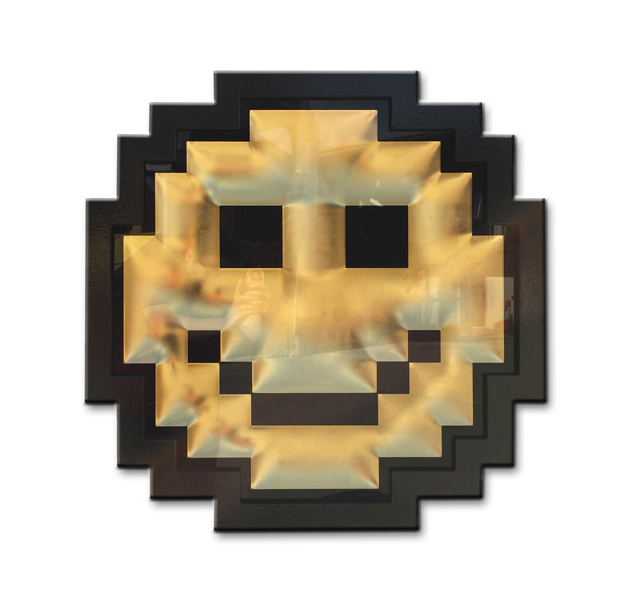Acid Biggie Buddha by Ryan Callanan. Image courtesy of the artist
The smiley face, now an emoji on our phones, was before that an icon of rave culture. Anyone who lived in the UK in the late 1980s will remember it being plastered across everything from record covers to t-shirts, badges, stickers, hats, bags, and more. So popular was the craze that even kids would walk around with t-shirts exclaiming slogans like “Have a nice trip”—not understanding its significance and association with acid house.
Videos by VICE
One of those kids was British artist Ryan Callanan, a.k.a., RYCA. Now, the iconic yellow grinning orb, which has featured throughout his art, is the focus for his new show, 10 Years Later, currently on at London’s Lawrence Alkin Gallery. “My dad was into the rave scene and I have vivid memories of the music, the after parties and the fall out from the drugs,” Callanan tells The Creators Project.
Acid Abstractions 1 by Ryan Callanan. Image courtesy of the artist
The show features various interpretations of the smiley face, from abstract reinventions, melting sculptures, to religious statues gone smiley, lacquered wooden signs, pixelated and blissed out golden versions, and more.
Some of the methods and skills Callanan uses he learned when he was a sign maker for various pubs in London and Edinburgh—many of his signs are still available to view including, in London, The Cambridge at Cambridge Circus, The Porcupine on Charing Cross Road, The Three Greyhounds at Old Compton Street, the Hoop and Grapes in Aldgate, and more.
Free House by Ryan Callanan. Image courtesy of the artist
While making these, Callanan learned techniques that date back to Victorian signage, like inverted relief text, gilding, wrought iron design, swing sign design, and manufacturing and lettering rules. “The latter is heavily neglected in most contemporary graphic design,” notes the artist, explaining that making the signs taught him “pure skill, applying techniques that require discipline and dedication. I’m intrigued by the fundamentals of letterforms and what you can do with text in space.”
For the acid house smiley faces and other imagery in the show, Callanan mixed this Victorian craftsmanship with the bright hues, shines, and pastiching associated with Pop art icons like Jeff Koons and Andy Warhol, along with taking influence from contemporary artists like the dimensional paintings of Adam Neate—”3D is everywhere and it’s a language that the kids of tomorrow will have in all aspects of life,” says Callanan—and artist, toy maker, and sculptor Kaws, who he believes “is the most important artist in the world right now.”

Dropper by Ryan Callanan. Image courtesy of the artist
Callanan also uses a mix of modern techniques too. His hand-drawn sketches are turned into vectors, CGI, and then a CNC cut file which, once cut from a block, is cleaned, smoothed,and painted. “Industrial process has fascinated me since I first read about Warhol’s silkscreen printing process and how he re-appropriated it to make fine art,” he says. “I like to think of CNC as my equivalent of silkscreen printing. It seems to have been overlooked by many because of the emergence of laser cutting and now the 3D printing boom.”
The show marks ten years since Callanan turned professional artist and it’s also nearly 30 years since the smiley face became an emblem for going out and listening to 120bpm music in sweaty warehouses. “The acid smiley is history,” notes Callanan. “My art is about modern history and British culture, good vibes and humor. There is no other motif that encapsulates that better.”

Optical Disturbance by Ryan Callanan. Image courtesy of the artist

Acid Mary by Ryan Callanan. Image courtesy of the artist 
Pixel Pill by Ryan Callanan. Image courtesy of the artist
10 Years Later is on now until October 29 at Lawrence Alkin Gallery, London.
Related
‘Energy Flash’ Exhibit Revives Rave Culture in Belgium
Revisit the Art of 90s London Rave Culture with the Underworlds



